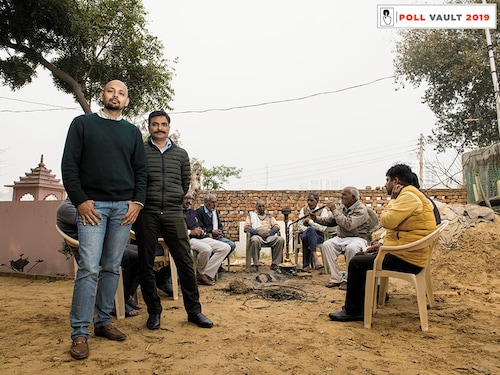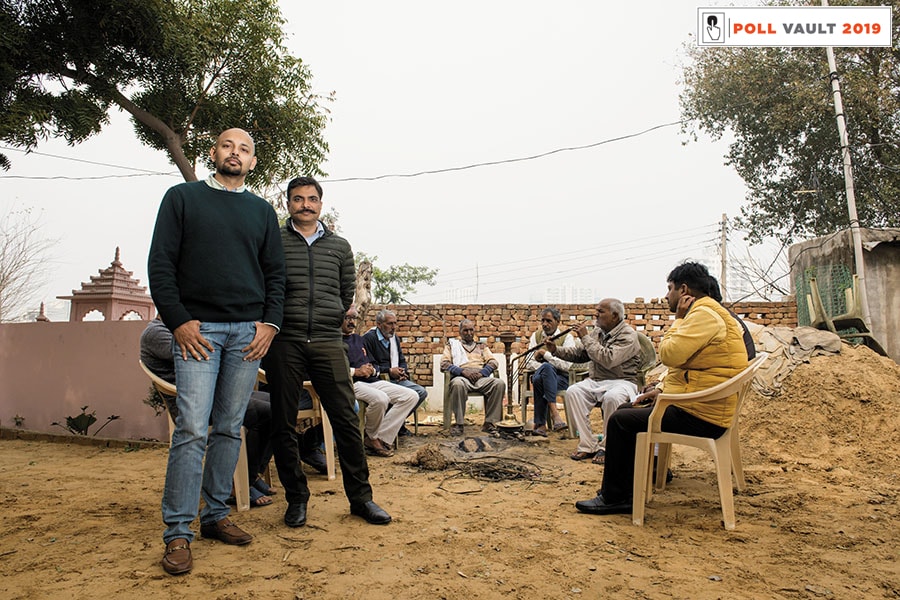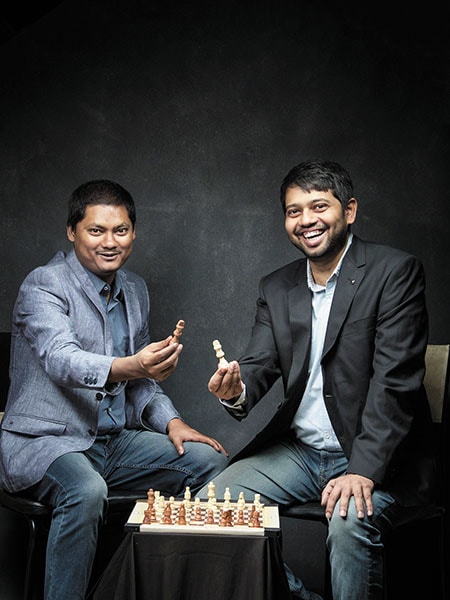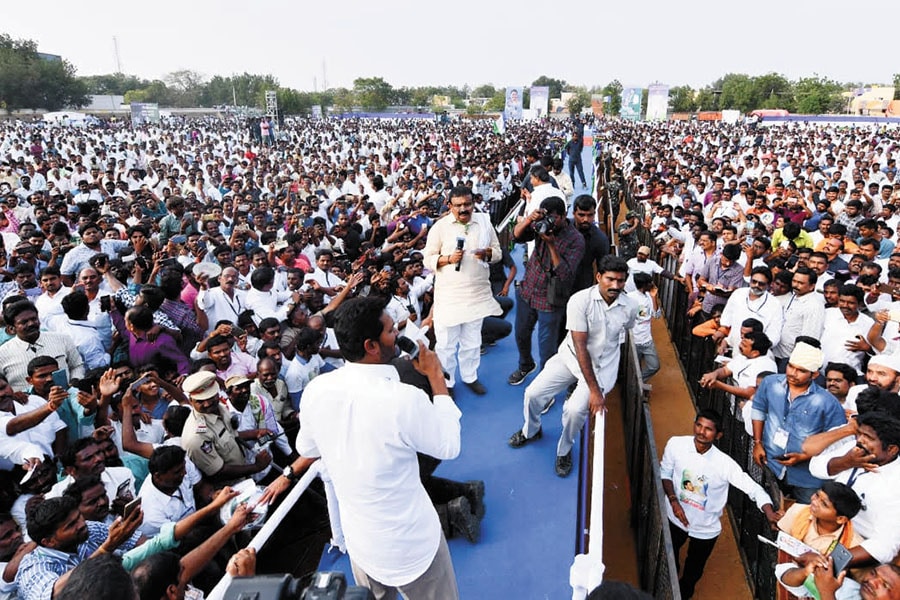Political strategists: The campaign makers
Political strategy and consulting firms have mushroomed across the country over the last decade. As India gears up for elections, they are already on the road, using data to drive campaigns that can h


 Gaurav Rathore (left) and Saurabh Vyas, co-founders of PoliticalEdge. Since 2011, it has advised more than 700 candidates across the country
Gaurav Rathore (left) and Saurabh Vyas, co-founders of PoliticalEdge. Since 2011, it has advised more than 700 candidates across the country
Image: Amit VermaIt was the winter of 2017. Amit Vij, then 39, was working as vice president-corporate affairs with Reliance Industries. Twenty-one days before the Punjab assembly elections in February, he ended up getting a ticket from the Indian National Congress to contest from Pathankot.
Vij is no stranger to politics as his father Anil Vij is a senior Congress leader from the same region. But this was his first big battle and Vij hired Gurugram-based political consulting firm PoliticalEdge to help him strategise for the election. After all, he was contesting against BJP’s Ashwani Kumar Sharma, who had won the seat in 2012 with a 19 percent margin.
“There were challenges at various levels as Amit was contesting against a seasoned politician,” says Saurabh Vyas, founder, PoliticalEdge.
After analysing Vij’s profile and the demography of the Pathankot constituency, PoliticalEdge came up with three important insights: To focus on youth and promise to industrialise and create jobs, to use his personality trait of being humble and soft-spoken to differentiate him from others, and lastly, as he was not seen in the constituency as a regular politician, it was decided that he would do a rigorous door-to-door house campaign, spending 18 hours on the field every day.
“The strategy, based on data insights, was dynamically changing and we had to create a data analysis and war room from the very first day,” says Vyas. “It was like a 24-hour cycle where at the end of the day you recalibrate the campaign and fine-tune the strategy for the next day... we did this over ten days till the final campaign took shape.”
He adds that once the campaign was curated, effective distribution of content in the last ten days was the next challenge. “We did this through social media, volunteer training, party worker training, field inputs, events for focussed groups and route mapping for the candidate for maximum output.”
undefinedA political campaign is usually months in the making. And every strategist has a different approach for their candidate[/bq]
Vij went on to win the seat with 56,383 votes, while the sitting BJP MLA managed 45,213 votes.
This is a small glimpse into the world of political strategy and consulting, which has mushroomed across the country over the last decade. As India goes to polls in 2019, the stakes are higher than ever. It is said elections are fought on emotions and they are an art more than science, but the rise of these geeks would suggest otherwise.
The Rise of Strategists
Vyas and Gaurav Rathore were batchmates at IIT-Bombay. Vyas has a dual degree in aerospace engineering, while Rathore studied metallurgical engineering and materials science, but their love for politics and data analytics skills brought them to political consulting.
They officially registered PoliticalEdge in 2011 and to date have advised over 700 candidates across the country, including Sachin Pilot for the Rajasthan Pradesh Congress Committee and for assembly elections 2018, Shashi Tharoor, Milind Deora and HD Deve Gowda for the 2014 general elections, among others.
“We always propose the candidate a jump of 4-6 percent vote share especially while working with individual leaders, by using all our expertise, but it’s never a victory promise. When we work with parties, a 5 percent margin share can help a party form a government,” says Vyas.
The numbers testify to this. For example, during the Madhya Pradesh state assembly elections in 2018, Congress won 114 seats, the BJP 109 seats while the None Of The Above option played a significant role as 1.2 percent population of the state or 542,295 voters opted for it. Similarly, during the Gujarat state assembly elections, 16 Congress candidates lost by less than 3,000 votes, a crucial factor that every party is taking note of.
While PoliticalEdge was charting its story from its office in Gurugram, the breakout poster boy of political consulting had emerged in the form of Prashant Kishor whose team advised the Narendra Modi-led BJP to a resounding win of 282 seats in the 2014 general elections. No party had come to power with such a majority since 1984.
Kishor started Citizens for Accountable Governance (CAG) as a non-profit in 2013. Two years later, it was rechristened Indian Political Action Committee (I-PAC), which has since strategised and campaigned for candidates in five elections. In 2014, it launched some of the marquee campaigns to build ‘brand Modi’ like Chai Pe Charcha (conversations over tea) and the Statue of Unity movement it also implemented 3D hologram rallies in India for the first time with Modi while positioning him as Vikas Purush (man of progress).
Kishor is now a political leader with the Janata Dal United (JDU) in Bihar but I-PAC is presently working with the regional YSR Congress Party (YSRCP) led by Jagan Mohan Reddy for the upcoming state and general elections.
Arindam Manna (left) and Partha Pratim Das founded Chanakyya in 2013
Image: Nishant Ratnakar for Forbes IndiaIn its latest campaign strategy devised by I-PAC called Samara Shankaravam, YSRCP has formed a network of 505,120 booth-level workers with one convenor and 10 workers at each booth in Andhra Pradesh. Through this, Reddy will meet booth-level workers in each of the 13 districts in the state.
Partha Pratim Das got into consulting when for his final project at IIM-Bangalore he advised Dr Ajay Singh, who was contesting from Jewargi, Karnataka, in 2013 for the state assembly elections. Singh went on to defeat the sitting BJP MLA by 36,700 votes. Das founded political strategy firm Chanakyya in November 2013 along with Arindam Manna, and his team and he once again worked with Singh in 2018 to win the same seat.
Das is advising a political party in northern India for the upcoming general elections and two potential MP candidates in Karnataka.
Likewise, Tushar Panchal founded WarRoom Strategies in 2016. It has a 40-member team that expanded to hire 700 more people to work with them during the 2018 Chhattisgarh assembly elections. The firm was strategising for a political party to contest elections and once polls were over, it was back to being the small team.
How they swing it
A political campaign is usually months in the making and every strategist has a different approach of creating one for their candidate. Generally, the strategists offer end-to-end services to a politician or a political party, and start work five to six months ahead of the elections.
They offer data services, which include poll-booth data of each constituency, historical data on how the seat has witnessed a shift in voting patterns as well as on-ground surveys to understand the concerns of the voters (electricity or minimum support price for grains, jobs, savings, increase in food prices or at best survival), and then create a campaign and advise the politician and ground workers to implement the same.
“We have booth-level past election data and we explain to political workers how people have voted in the past from his or her village, equipping them with information. For a candidate to win their respective seat, it is important that they win every polling booth and we help them achieve that target,” says Chanakyya’s Das.
Targeting too is key. “These days people have data on the basis of your public digital profile, your pin code which determines if you are in a particular area, what your socio-economic composition would be, the kind of phone you use to your mobile bills, your spending power... all forms of data is available, which is then dissected and targeted campaigns are created and sent to the individual,” adds Panchal.
One of the biggest shifts from the 2014 elections to the 2019 polls, as Vyas puts it, is targeted content sharing and how everyone is moving away from sending merely pictures to political videos to keep voters engaged.
“Social media is an important factor for communication. While Twitter is mainly used by political leaderships and influencers, YouTube, WhatsApp, Facebook and LinkedIn are important platforms to send communications to the general electorate,” says Das.
Political observers say parties and candidates are now sending messages in local languages through apps like ShareChat and TikTok and making videos of lower quality that could be easily downloaded and shared in bulk.
But Panchal strikes a word of caution, saying there is nothing new left in social media anymore and political parties have to be careful in their tone of conversation and the relatability of their campaign.
Besides, the job doesn’t end with elections. “Once the results are out, we do a post-poll review and try to learn what has worked and what didn’t, so that we can implement it in the next project,” adds Das.  Prashant Kishor’s Indian Political Action Committee works with the YSR Congress Party The Campaign Conundrum
Prashant Kishor’s Indian Political Action Committee works with the YSR Congress Party The Campaign Conundrum
Although there is a rise in the number of political consultants these days, one would have to go back in time to understand the rise of political strategists in India, a country so complex that every district represents a different story.
While the period from 2005 to 2011 saw some chief ministers and leaders being re-elected on the back of development, since then challengers have found it easier to beat incumbents. Caste and religion—two key ingredients in the Indian poll masala—have in the past decade become even more primary, arguably preceding development in a clutch of elections.
Panchal says, “There are no templates to win elections, each comes with its own challenges. People in India vote on the basis of caste, creed, religion, local factors, regional factors. In fact, we have observed that development has no agenda in electioneering.”
Then there is also the factor of floating voters, known as swing voters, who more often than not decide the fate of a candidate. In any election, it is the 3-7 percent swing in each constituency that determines which way the election is headed. As one political observer says, the whole thing comes down to try and find the swing voter and to get them to vote for you.
“The floating voter percentage is on the rise due to various social, political and economic changes that are constantly happening around us. It is usually 20 to 25 days before an election that swing voters start making up their mind on the basis of what a candidate stands for, and whether their campaign appeals to them or if it has a personal impact on their lives,” says Rathore of PoliticalEdge.
In his book Democracy On The Road, Ruchir Sharma notes that while working closely with Pramod Mahajan—the mastermind of BJP’s electoral strategy in the Atal Bihari Vajpayee era—it was politician Sudhanshu Mittal who brought the modern election war room to India. Together, Mahajan and Mittal had introduced the scientific use of data to identify winnable districts, steer funding and manpower to those battlegrounds, as well as identify candidates in Rajasthan.
But not all believe that data science in India is as evolved as it is in the global world. Also, political strategists don't get it right all the time. They have faltered on many occasions.
“Although the quality of data has improved, I still think that the process of data selection in India still remains unscientific,” says Sharma. “If you look at the data, it is still very much about candidate selection and to me it still appears to be like who has the most money, best family connections, the influence with the top leadership. I feel those factors are still the determining factors of it.”
Even before the Election Commission announced the poll dates, most political strategists were already on the road, advising parties and preparing their behemoth of content. And some of it has slowly been seeping into our phones and conversations. After all, politics is a hotly debated and contested topic in India.
First Published: Mar 14, 2019, 14:13
Subscribe Now